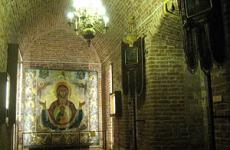Dome mosaic of the Ascension in St. Sophia Cathedral. Hagia Sophia in Thessaloniki
The Church of Hagia Sophia is a cross-domed, three-nave temple in the city of Thessaloniki, consecrated in the name of Sophia the Wisdom of God. This is a rare example of a church from the iconoclastic period, which combines the features of a three-nave basilica and a cross-domed church. In 1988, the Christian temple, as part of the city's early Christian and Byzantine monuments, was included in the list of UNESCO World Heritage Sites.
History of the temple
In the first half of the 5th century, on the site of the current temple, there was an early Christian five-slope Basilica of St. Mark. Along with other buildings, it was a complex of religious buildings, the total area of which was more than 8 thousand square meters. The first church on that site was destroyed by an earthquake in 618-620. The current temple soon appeared in its place, occupying only part of the previous territory of the complex.
Construction of the temple lasted from 690 to 730. The first written mention of it was found in a letter from Theodore the Studite dated 795. The completion of the construction of the Church of Hagia Sophia occurred during the reign of Emperor Leo III. Then iconoclasm began in the Byzantine Empire, which explains the minimal amount of mosaic decorations in the interior.
In the middle of the 11th century, the temple was rebuilt, adding a spacious narthex to its western part. The entrance gate was demolished, and the eastern wall of the narthex was decorated with fresco paintings.
In 1430, Thessaloniki was conquered by the Turks, but the temple was used for Christian worship until 1523, but it was soon converted into a mosque. The Turks changed the appearance of the Church of Hagia Sophia - the facade is decorated with an Ottoman-style portico, the bell tower was converted into a minaret, and a second minaret was erected in the Ottoman style. Nothing was changed inside, but everything was covered with plaster, preserving the mosaics of the cathedral.
In 1890, due to a fire, the building was dilapidated. In 1910, the Turks carried out repairs. In 1912, Thessaloniki returned to Greece and the Church of Hagia Sophia was returned to Christians. The Ottoman minaret was dismantled, and the bell tower was returned to its original function. Nowadays the temple is operational.
Architectural features
Dimensions of the temple: 42 by 35 meters, the diameter of the dome is 10 meters, the height of the arms of the cross is 16 meters. The architecture of the temple combines the features of a cross-domed temple and a three-nave basilica. The dome rests on sails supported by pillars. Deep domed arches stand out, forming cross-shaped diverging sleeves. The space of the temple is divided into three naves, but the side naves do not correspond to the apses at the junction of the central and side naves. The drum is rectangular in shape, and the dome is supported by semi-cylindrical beams.
The architecture of the Church of Hagia Sophia has a number of shortcomings: the base of the dome is not made in the shape of a circle.
Interior decoration
The temple has a square shape characteristic of late Byzantine cross-domed basilicas. Alternating antique and Byzantine columns divide the interior of the temple. For their columns, capitals were used, topped with two rows of developing leaves, borrowed from an older temple of the 5th century. The walls are plastered and made to resemble marble, with floral patterns applied to them.
Mosaics and frescoes from the 11th century have been preserved here, arranged in a row on the eastern wall of the narthex.
In contact with
It is an exceptionally rare example of a church from the iconoclastic period, combining the features of a cross-domed church and a three-nave basilica.
In 1988, as part of early Christian and Byzantine monuments, it was included in the list of UNESCO World Heritage Sites.
History of the temple
In the first half of the 5th century, on the site of the existing temple, there was an early Christian five-slope basilica dedicated to St. Mark. Together with other buildings, it was a complex of religious buildings with an area of more than 8,000 square meters. m. This church was destroyed by an earthquake in 618–620, and in its place the current temple was built, occupying only part of the former complex.
The construction of the temple dates back to the period between 690 and 730, and the first written mention of it is contained in a letter from Theodore the Studite dated 795. The completion of the construction of the Hagia Sophia falls during the reign of Emperor Leo III, during which iconoclasm began in the Byzantine Empire, which explains the minimal number of mosaic decorations in the temple.
During the Byzantine period, the temple was surrounded by numerous administrative and religious buildings. John Kameniata, describing the churches of Thessaloniki at the beginning of the 10th century, calls the Church of Hagia Sophia one of the most outstanding.
In 1357, Archbishop Gregory Palamas was buried in the temple, soon canonized as a saint, and his relics began to be revered as a source of miracles. In the 10th century, St. Sophia Cathedral became the cathedral church of the Thessalonian Metropolis. During the period of the conquest of the city by the Crusaders and the existence of the Kingdom of Thessalonica, the see of a Catholic bishop was located in it.
Around the middle of the 11th century, the temple was rebuilt. A spacious narthex was attached to its western part. The entrance gate of the previous building was demolished, and the eastern wall of the narthex was decorated with fresco paintings.
After the conquest of Thessaloniki by the Turks in 1430, the temple continued to be used for Christian services until 1523, but then, like other temples in the city, it was converted into a mosque.
Kimdime69, Public DomainThe Turks changed the appearance of the temple - the facade was decorated with a portico in the Ottoman style, the bell tower was converted into a minaret, and then a second minaret was erected in the Ottoman style. The interior of the temple was not destroyed; it was covered with plaster, which preserved the mosaics of the cathedral. In 1890, a fire caused significant damage to the building. In 1907–1910 the Turks carried out repairs.
In 1912, as a result of the First Balkan War, the city of Thessaloniki passed to Greece and Hagia Sophia was returned to Christians. The Ottoman minaret was dismantled and the bell tower was returned to its original function. The temple is active and belongs to the metropolis of Thessaloniki. In modern Thessaloniki, the cathedral is located in the historical center of the city, and the street and square in front of the temple are named after St. Sophia.
Interior decoration
The temple has a square shape, typical of late Byzantine cross-domed basilicas. Ancient and Byzantine columns, alternating, divide the interior of the temple. For the columns, capitals were used, decorated with two rows of developing leaves (similar to the capitals in the Basilica of St. Demetrius), which were borrowed from an older temple, probably from the 5th century. The walls of the temple are plastered and painted to resemble marble. In a number of places, floral patterns are applied.
 Fingalo, CC BY-SA 2.0
Fingalo, CC BY-SA 2.0 The dome of the temple rests on a cylindrical drum, which, as it descends, takes the shape of a square with twelve windows, the space above which is covered with a mosaic depicting the Ascension. The vault of the apse of the altar is also decorated with mosaics, where there is a mosaic image of the Virgin Mary, belonging to the Hodegetria icon painting type.
In addition to mosaics, the temple preserves frescoes from the 11th century, which were made during its reconstruction after the fire of 1037. The frescoes are located in a single row on the eastern wall of the narthex. Most of them depict saints who have been canonized as venerables. Notable among them are St. Theodora and St. Euthymius, saints from Thessaloniki.
Mosaics
Mosaic of the apse - " Hodegetria»
The temple was built during the period of iconoclasm, and therefore the apse was initially decorated with a huge cross, and the vault with numerous small crosses in rectangles (the so-called aniconic decoration).
These mosaic images were created in the 780s (that is, after the first restoration of icon veneration by Empress Irene or shortly before it). This dating is based on the surviving monograms of Constantine VI, his mother Empress Irene and an inscription mentioning Bishop Theophilus, who was a participant in the Seventh Ecumenical Council in 787.
They are located in the altar vault next to a large image of an equal-armed cross in a circle.
 unknown, Public Domain
unknown, Public Domain Soon after the final restoration of icon veneration by Empress Theodora in 843, the image of the cross was replaced by a mosaic image of the Virgin Mary seated on a throne, holding the Christ Child in her arms.
The image is made on a gold background. The master who created the mosaic was not familiar with the principles of correcting perspective distortions. For this reason, the figure of the Mother of God he created on the semicircular surface of the apse turned out to be wide and heavy, and the figure of the Infant Christ, on the contrary, was too small.
At the level of the Virgin Mary's shoulders, the contours of the cross that originally adorned the apse have been preserved. Under the image of the Virgin Mary there is an inscription relating to the original mosaic decoration of the apse:
« Lord God, make this building strong, so that it will be unshakable until the end of the age, so that You, Your Only Begotten Son and Your Most Holy Spirit may be glorified».
Between the altar vault and the arch, on the narrow front part, a quotation from Psalm 64 is laid out in mosaic:
“Let us be satisfied with the good things of Your house, Your holy temple”(Ps. 64:5).
Dome mosaic - “Ascension”
The large mosaic of the dome depicts the scene of the Ascension of Jesus Christ. The image of Christ is enclosed in a multi-colored spherical frame - a mandorla, raised into the sky by two angels. Christ, blessing with his right hand, is depicted sitting on a rainbow.
 unknown, Public Domain
unknown, Public Domain Around this central image are depicted the twelve apostles and the Virgin Mary, surrounded by two angels, one of whom points to the words from the acts of the apostles written above their heads:
“...men of Galilee! Why are you standing and looking at the sky? This Jesus, who was taken up from you into heaven, will come in the same way as you saw Him going into heaven.”(Acts 1:11).
Regarding the dating of this mosaic, the following versions exist:
- according to Charles Diehl and M. Le Tourneau, it was created in two stages: Christ with angels - 7th century, Our Lady, angels and apostles - 9th century. This dating, according to St. Petersburg University professor D.V. Ainalov, has no basis;
- Academician V.N. Lazarev dates the mosaic to the 9th century based on its similarity with the paintings of the sixth chapel in Goreme and with the mosaics of the San Zeno Chapel in the Basilica of Santa Prassede. Also in favor of such a dating, in his opinion, is the inscription preserved in the dome mentioning Archbishop Paul of Thessaloniki (880-885), which may have been made simultaneously with the mosaic.
- art critic G. S. Kolpakova dates the mosaic to ca. 849, that is, the first years after the final restoration of icon veneration.
The images of the apostles are separated from each other by trees. The master tried to convey the individual features of each apostle: one looks at the sky, covering his eyes with his hand, the other is presented thoughtfully with his head slightly lowered, which he supports with his hand, the third expresses amazement, tilting his head and squeezing his hand at his chin. The apostles, unlike Christ and the Mother of God, are depicted without a halo. The Virgin Mary is depicted in a prayer position with her hands raised up.
 unknown, Public Domain
unknown, Public Domain Describing the mosaic technique, the Austrian art critic Otto Demus writes that it represents an example of an ideal optical system of negative perspective, characteristic of Middle Byzantine art.
The long legs of the figures, that is, those parts of them that are located on more or less vertical and therefore subject to strong contraction areas of the dome, shortened torsos, small heads - in a word, everything is depicted in such a way that, when viewed from below, the proportions of the figures seem normal. Even the somewhat strange image of the seated Christ at the zenith of the dome gets to the point - the viewer perceives His figure as almost undistorted, which means that it turns out to be smaller and wider. Its relative awkwardness is due to the fact that the image of a seated figure on a horizontal surface viewed from below was an almost insoluble problem for the Byzantine artist.
He also notes that the placement of the Ascension of Christ composition in the dome is an example of archaic iconography and the non-placement of Christ Pantocrator, traditional for the capital art of Byzantium, in the dome is explained by the provincial position of Thessaloniki. G.S. Kolpakova classifies mosaic as an example of archaic folk taste, but notes that it is distinguished by “ academization of techniques, increased stylization of volumes, their precision, ornamentalization of the outlines of details».
 unknown, Public Domain
unknown, Public Domain This mosaic became the prototype for the painting of the dome of the Transfiguration Cathedral of the Mirozh Monastery (mid-12th century), and its individual motifs were used to create the mosaic composition of the concha of the altar of the Lutheran Church of the Ascension in Jerusalem (1907-1910).
Photo gallery









Helpful information
Church of Saint Sophia
Greek Ἁγία Σοφία
Cost of visit
for free
Opening hours
- 24/7, external inspection,
- Mon–Sun: 08:00–13:00 and 17:00–21:00
Address and contacts
Greece, 54623, Thessaloniki, st. St. Sofia, 39
Agias Sofias 39, 54623 Thessaloniki, Greece
☎ +(30 2310) 27 02 53
Status
UNESCO World Heritage Site No. 456
brief information
Architectural features
The dimensions of the temple are 42 (length) by 35 (width) meters, the diameter of the dome is about 10 meters, and the height of the arms of the cross is about 16 meters. The architecture of the temple combines the features of a cross-domed temple and a three-nave basilica. The dome rests on sails that rest on pillars. Very deep arches under the dome stand out, which form cross-shaped sleeves diverging from the dome. At the same time, the space of the temple is divided into three naves, although the side naves do not correspond to the apses, which are located at the junction of the central and side naves. The architectural elements that characterize the transition from a domed to a cross-domed basilica also include the fact that the drum has a rectangular shape, the dome is supported by semi-cylindrical beams:95.
A number of shortcomings are visible in the architecture of the temple (for example, the base of the dome is not circular, but almost quadrangular with rounded corners), which are explained by the fact that the architect has probably not yet mastered the construction of a new type of church with the dome based on arches: 94-95. The general style of the monument is provincial, although the scale of construction and the complexity of the composition indicate the restoration of architectural traditions of the 6th century. According to art critic V.D. Likhacheva, the Church of Hagia Sophia resembles the Constantinople buildings of Justinian and, first of all, the Church of Hagia Irene.
In the architecture of the altar part, new architectural forms are visible, caused by changes that have occurred in the rite of the liturgy: for the preparation of the Holy Gifts, a room was made for the altar, and to the right of the altar, symmetrically to the altar, there is a deaconnik for storing church utensils and vestments:96.
The interior of the temple is divided by two rows of columns, the dome arches are supported by four volumetric columns of the Byzantine style, and the nave has a cross vault.
Inclusion as a World Heritage Site
On January 15, 1987, Greece nominated a group of early Christian and Byzantine monuments in the city of Thessaloniki, including the Hagia Sophia, for inclusion as a UNESCO World Heritage Site. In September 1988, the International Council for the Conservation of Monuments and Sites presented its opinion justifying the possibility of their inclusion in the register. At the 14th session of the World Heritage Committee, held in Brazil from December 5-9, 1988, this group of monuments was included in the List of World Heritage Sites under number 456.
The country of strong men and beautiful women is the ancestor of existing civilization. How generously the gods rewarded this land: sea and forests, clean air and water, warm climate, many islands. And, of course, the countless attractions of Greece attract numerous tourists to the country.
The oldest church on the planet
Two blocks from the Temple of Panagia Achiropiitos is the Church of Hagia Sophia. Researchers have established that this church in Thessaloniki was built between 527 and 565. The original building was destroyed in 620 by a terrible earthquake. The modern church has existed since the mid-7th century and serves as a rare example of a temple structure from the iconoclastic period. It was built according to the plan of a domed basilica. The oldest mosaic is on the altar vault: a large cross is depicted. It is inscribed in a circle of stars and monograms of the benefactors and patrons of the temple, Emperor Constantine VI, his mother Irene and Metropolitan Theophilos of Thessalonica. The huge dome is covered with an excellent mosaic depicting the Ascension of the Lord from the 19th century. The apse of the altar is decorated with an amazing mosaic of the 20th century “The Virgin on the Throne”.
Until 1912, when the city was captured, Ottoman raiders used this structure as a mosque. But since then everything has returned to normal. And the church pleases with its beauty and grandeur.
A living witness and participant in centuries-old events
Thessaloniki became a witness and participant in the events of three great civilizations: Ancient, Roman, Byzantine. This is a kind of capital of Northern Greece, a connection of continents and trade routes. The city was founded before our era on the site of the ancient settlement of Thermi by the Macedonian king Cassander. He gave the city the name - Thessalonica. This is the name of his wife and half-sister of Alexander the Great. The entire turbulent history of Thessaloniki at its founding is the personification of the glory and power of the Macedonian dynasty. This is the favorite city of all the kings of Macedonia. Even in the Byzantine chronicles it is spoken of as a “brilliant and proud city”, a “Queen” and a “crowded city”. It not only was, but remains the cultural and political center of Greece. Thessaloniki is also famous for its unique attractions, one of which is
One of the oldest and most beautiful temples in Thessaloniki is the Hagia Sophia. This temple, like the Basilica of Dmitry of Salunsky, belongs to ancient Christian buildings. It is difficult to get into; it is mostly always closed. A temple was built in honor of Christ, as well as the St. Sophia Cathedral in Istanbul; these two temples have much in common.

The architecture of the temple is almost a square, divided into three naves. In the center of the square, four pillars and arches support a huge dome, which is surrounded by a square drum and forms a cross.

Around the dome there is a row of arched windows that illuminate the dome and the beautiful mosaic panel of the Ascension of Christ. The temple is divided into naves by antique and Byzantine columns, which separate the central part from the side aisles, which, together with the vestibule, form a bypass gallery.



The altar, consisting of three parts, is attached to the east to the four-sided structure of the temple as an independent architectural structure.

The interior decoration of the temple dates back to three different periods. The first period dates back to the time of iconoclasm. At this time, instead of icons in churches, only images of the cross were used, instead of old paintings, decorative images of plants and animals were made, and secular scenes were depicted. At the moment, from that era, the temple has preserved an ornament consisting of crosses and leaves, marked with mosaic monograms belonging to Emperor Constantine VI, as well as a large iconoclastic cross in the conch of the altar apse, of which only a shadow remains under the image of the Mother of God, who sits on throne, with the Christ Child in his arms. This mosaic dates back to the third period of temple decoration of the 11th or 12th centuries.

The frescoes that have been preserved on the window vaults date back to the same period; the frescoes depict images of holy monks, as well as Saint Theodora of Thessaloniki.


Well, the second stage includes the beautiful domed composition “Ascension”, the end of the 9th century of the so-called “Renaissance of the era of the Macedonian emperors”.

The temple has a rich history; during its existence it was a cathedral, a Catholic church, and a mosque. During the existence of the mosque, the interior decoration of the temple was not destroyed, since a layer of plaster was applied on top of the most valuable mosaics. In 1890, the temple was very badly damaged in a fire, but in 1907-1910 the Turks made repairs. And in 1912, Hagia Sophia was returned to Christians. The temple is included in the list of UNESCO World Heritage Sites.

You can see other photos of the monastery




